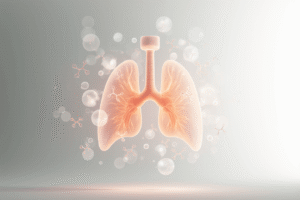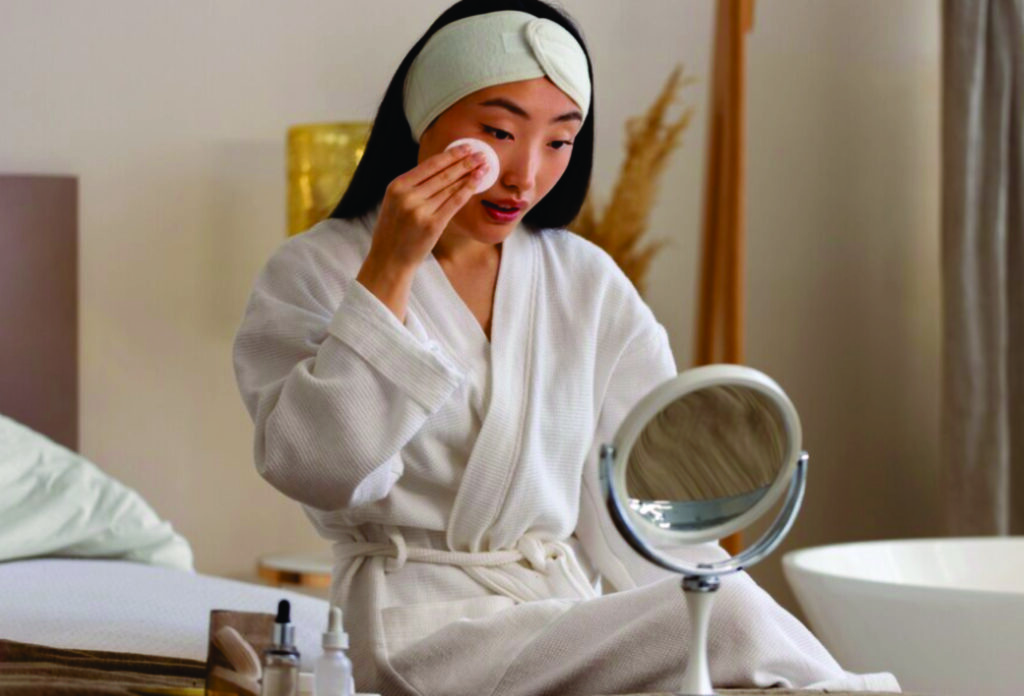Your skin is more than a surface — it’s a reflection of your inner world. Dermatologists and researchers increasingly emphasize the skin-health link, a complex relationship connecting your complexion to the state of your gut, hormones, stress, and overall well-being. When something inside the body falls out of balance, the skin often signals distress long before other symptoms appear. By understanding what your skin is trying to tell you, you can make informed lifestyle changes that support both internal health and visible vitality.

The Gut–Skin Axis: When Digestion Shapes Complexion
Modern dermatology now views the gut as a powerful influencer of skin health. A 2023 review published in Frontiers in Microbiology confirmed that gut dysbiosis — an imbalance in intestinal bacteria — can trigger inflammation that manifests as acne, eczema, or rosacea (Frontiers, 2023). The gut and skin communicate through immune pathways, hormones, and metabolic byproducts, forming what scientists call the “gut–skin axis.”
When the gut barrier weakens (a phenomenon often described as “leaky gut”), toxins can enter the bloodstream and activate the immune system. The result? Flushed cheeks, unexpected breakouts, or chronic dryness.
Forum story: On a popular acne forum, a user named LilyM wrote,
“I was on antibiotics for six months, and my skin exploded with redness afterward. My dermatologist mentioned gut bacteria. I started eating kefir every day and noticed my skin calming down after about three weeks.”
Her experience aligns with recent findings in the Journal of Clinical and Aesthetic Dermatology, which observed improvements in acne severity among participants taking probiotic supplements (JCAD, 2022). Researchers believe probiotics help restore the gut’s microbial balance, indirectly reducing inflammation in the skin.

Foods that Foster Balance
- Probiotics: Found in kefir, yogurt, kimchi, and sauerkraut.
- Prebiotics: Present in fiber-rich foods like onions, garlic, oats, and bananas.
- Omega-3 fatty acids: In salmon, flaxseeds, and walnuts — known for anti-inflammatory effects.
Hormones: The Invisible Architects of Skin Behavior
Hormones are among the strongest internal drivers of skin change. They regulate sebum production, hydration, collagen, and pigmentation. When hormones fluctuate, skin symptoms can appear suddenly.
- Androgens and Acne: Elevated androgen levels — seen during puberty, stress, or PCOS — boost sebum production and clog pores. Studies in the Journal of the American Academy of Dermatology have linked androgen excess and insulin resistance to persistent adult acne (JAAD, 2021).
- Thyroid Function: Hypothyroidism can cause dull, flaky skin; hyperthyroidism can make it oily and sensitive.
- Estrogen and Melasma: Hormonal shifts during pregnancy or contraceptive use can lead to pigmentation known as melasma.
Forum story: “I went off the pill and broke out worse than I ever had,” wrote user Kara88 on Reddit’s SkincareAddiction. “Cutting out sugar helped, but managing stress made the biggest difference.” Her anecdote echoes a 2020 Harvard Health article explaining how stress-related cortisol spikes can raise androgen levels and trigger acne.

Inflammation: The Hidden Culprit
Chronic inflammation is now recognized as a unifying cause of many skin disorders. According to a 2024 paper in the International Journal of Molecular Sciences, systemic inflammation accelerates aging, worsens barrier function, and fuels conditions like psoriasis, rosacea, and eczema.
Inflammation is influenced by:
- Poor diet high in sugar and trans fats
- Sleep deprivation
- Chronic stress
- Exposure to environmental toxins
Anti-inflammatory allies: Turmeric, ginger, berries, and leafy greens. A Mediterranean-style diet rich in olive oil and vegetables has been shown to reduce inflammatory markers and improve skin elasticity (Nutrients, 2022).
The Role of Stress and Sleep in Skin Repair
Psychodermatology — a growing field linking psychology and dermatology — offers compelling evidence that emotional stress affects skin directly. A Harvard Medical School review found that cortisol (the stress hormone) breaks down collagen and increases oil production, contributing to premature aging and acne.
Sleep, too, is essential. A 2023 Clinical and Experimental Dermatology study demonstrated that poor sleepers exhibited more fine lines, uneven pigmentation, and reduced elasticity. During deep sleep, growth hormones stimulate cell repair and collagen renewal.
Forum story: “I started going to bed at 10 p.m. instead of 1 a.m., and my skin tone evened out within a month,” one Redditor wrote. “No cream ever did that.” Her observation aligns perfectly with clinical evidence — skin renewal peaks between 11 p.m. and 2 a.m., when the body’s repair mechanisms are most active.
Nutrition: Feeding the Skin from Within
You are, quite literally, what you eat. Research continues to show that certain nutrients profoundly impact skin structure and glow.
- Vitamin A: Encourages cell turnover and prevents acne. Found in carrots and sweet potatoes.
- Vitamin C: Boosts collagen and protects against UV damage. Present in citrus fruits and berries.
- Zinc: Supports wound healing and oil regulation. Found in pumpkin seeds and seafood.
- Omega-3s: Reduce inflammation and promote moisture retention. Present in flaxseeds, salmon, and walnuts.
A 2021 American Journal of Clinical Nutrition study concluded that diets high in plant-based antioxidants correlate with lower rates of acne and delayed visible aging.
Forum story: “When I swapped breakfast cereal for oatmeal with chia and berries, my skin stopped flaking around my nose,” one user posted on a wellness forum. It’s a small change — but consistent with data linking stable blood sugar and improved skin hydration.
The Simplicity Principle: Why “Less” Works Better
The skincare market pushes a constant stream of new actives — yet dermatologists increasingly recommend minimalism. Over-exfoliating, mixing acids, and layering too many serums often damage the skin barrier.
Adina Grigore, author of Skin Cleanse, argues that overuse of harsh ingredients strips natural oils, causing sensitivity and inflammation. A simple, barrier-focused routine is best:
- Gentle cleanser (pH-balanced, fragrance-free)
- Moisturizer with ceramides or glycerin
- Daily SPF 30+ broad-spectrum sunscreen
- Occasional targeted treatment, only when needed
“The Skin-Health Link” isn’t just about what you put on your face but also what you avoid — unnecessary stress, sugar, and aggressive skincare trends.
Lifestyle Choices That Strengthen The Skin-Health Link
To make visible changes, address the foundation of well-being: 
- Hydrate intentionally. Studies show that consistent water intake (around 2 liters daily) improves skin hydration in people who usually drink less. Pair internal hydration with humectants like hyaluronic acid externally.
- Move your body. Exercise boosts circulation, delivering oxygen and nutrients to skin cells. A JAMA Dermatology article (2022) highlighted improved collagen density among participants who exercised regularly.
- Protect from the sun. UV exposure accelerates collagen breakdown. Daily SPF remains the single most evidence-based anti-aging tool available.
- Practice stress hygiene. Mindfulness, yoga, or even short walks lower cortisol and visibly reduce redness and dullness over time.
What Your Skin Might Be Telling You
| Skin Symptom | Possible Internal Cause |
|---|---|
| Dull or sallow tone | Nutrient deficiency, fatigue, poor circulation |
| Puffy eyes | Dehydration, allergies, or high sodium intake |
| Persistent acne | Hormonal imbalance, stress, or gut dysbiosis |
| Chronic dryness | Low thyroid function or lack of essential fatty acids |
| Uneven pigmentation | Inflammation or hormonal changes |
Tracking these patterns alongside diet, cycle, and stress levels can reveal personal triggers.
Realistic Expectations
Not every change brings instant results. Gut flora restoration can take weeks; hormone regulation may take months. Consistency and observation matter more than perfection.
Forum story: “I kept a skin diary for 60 days,” one user shared. “When I finally saw the connection between my sleepless nights and my flare-ups, it clicked. Now my skincare is simple — and my skin’s never been calmer.”
Such experiences, while anecdotal, embody the practical essence of modern dermatology: understanding internal patterns to restore external balance.
Conclusion: Listen to the Language of Your Skin
Science is catching up with what many have intuitively known — healthy skin begins within. By embracing the skin-health link, you align your habits with your biology: eating clean, sleeping well, managing stress, and keeping your skincare simple. The reward is not just a clearer complexion but a deeper harmony between body and mind. After all, radiant skin is less a beauty goal and more a reflection of well-being lived daily.
References
- Frontiers in Microbiology (2023). “The Gut–Skin Axis: Mechanisms and Therapeutic Perspectives.”
- Journal of Clinical and Aesthetic Dermatology (2022). “Probiotics in the Management of Acne Vulgaris.”
- Journal of the American Academy of Dermatology (2022). “Androgens and Acne: Insights from Hormonal Pathways.”
- International Journal of Molecular Sciences (2024). “Inflammation and Skin Aging: Mechanistic Links.”
- Nutrients (2022). “Mediterranean Diet and Skin Health.”
- Clinical and Experimental Dermatology (2023). “Sleep Deprivation and Cutaneous Aging.”
- Harvard Health Publishing (2020). “Stress and the Skin.”
- American Journal of Clinical Nutrition (2021). “Dietary Antioxidants and Skin Health.”
- JAMA Dermatology (2022). “Exercise and Collagen Density.”
How to Choose a Basic Skincare Routine Based on Your Skin Type
The Science Behind Double Cleansing: A Must-Have Skincare Routine

I’m Victoria, the creator behind Eva My Balance. Passionate about beauty, wellness, sustainable living, and mindful self-care. My mission is to inspire you to live consciously and beautifully—inside and out.


